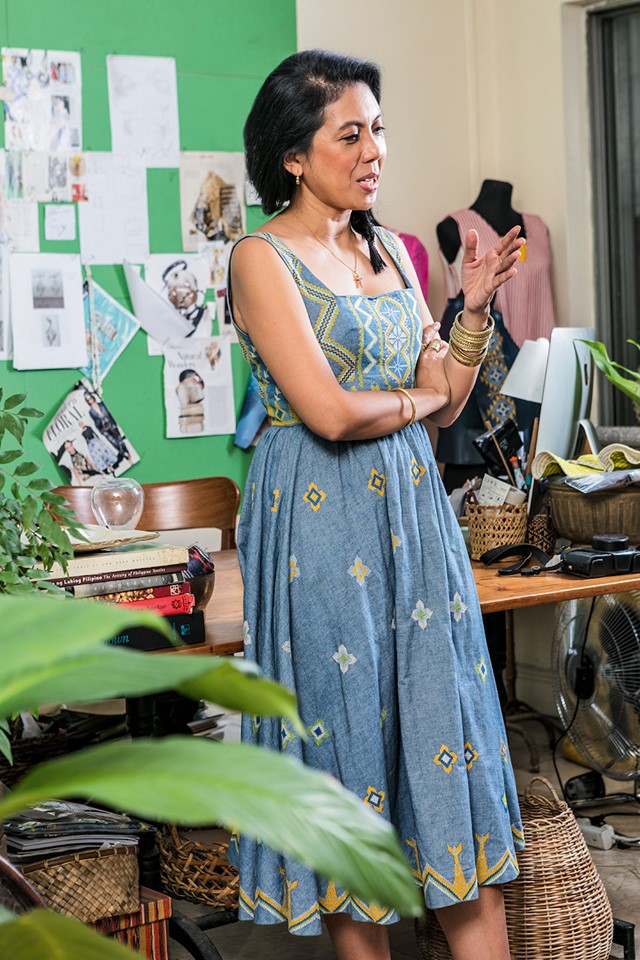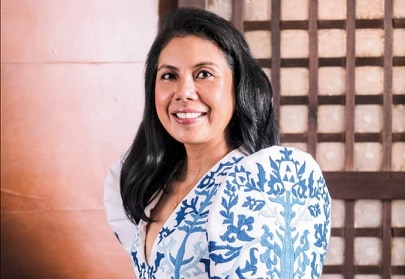By Alex Y. Vergara/ Photography by Jar Concengco / Hair and makeup by Eddie Mar Cabiltes
The creative director of Filip+Inna ventured into fashion design because of her love for Philippine culture. But when she saw her collaborators, a group of indigenous women, crying out of gratitude for the recognition and steady work, the business venture’s perspective suddenly shifted from hers to theirs.
Even before she became owner and creative director of Filip+Inna (pronounced as Filipina), a homegrown clothing brand consisting of dresses and separates hand-embroidered and embellished by women from the country’s various indigenous tribes, fashion designer Len Cabili had already experienced her fair share of life’s curveballs.

Like most individuals, she felt daunted at first while dealing with the disruptions these surprises brought, including initially not finding a market for her artisanal pieces and later realizing that failure wasn’t an option because a legion of women and their families were depending on her to sell their output. But instead of letting her fear paralyze her, Len allowed her optimism and deep Christian faith to take over.
Unlike most of her colleagues, Len never considered herself fashionable while growing up. “I had style, but I wasn’t fashionable,” Len shares with PeopleAsia one afternoon at her Mandaluyong home, which also doubles as her office and design studio. “When I look back now at my old pictures, I realize I had a certain way of wearing clothes.”
In the know

Although she’s more appreciative than the average Filipino of the country’s native fashion, thanks in part to her Mindanao roots and the fact that she once wore some of these tribal attire as a member of the Bayanihan dance troupe, Len never imagined herself one day mining and celebrating the richness of traditional fabrics and embellishments from such diverse tribespeople as the Tausugs, T’bolis and Maranaos from the South, and the Ga’dangs, Tinguians and Ifugaos from the North, just to name a few.
The other component of her thriving business consists of two design assistants in Mandaluyong and 18 people who cut, sew and finish dresses and various articles of clothing in a Taguig workshop. Made mostly of linen and chambray, these pieces will become the embroiderers’ canvas later on.
Lately, Len has also started venturing into stylized and embroidered ternos, which take her and her team at least four months to make. To produce them, she also collaborates with embroiderers from Lumban and Taal.
“Even then, I imagined myself mixing a more traditional top, say, with jeans,” she shares, chuckling. “But I never got to do it until much later because I was dancing for Bayanihan while studying.”
Heck, this fairly healthy and bubbly woman never imagined that she’d be at death’s door in her late twenties, dealing with thyroid cancer in 2000, less than a decade after finishing Clothing Technology at the University of the Philippines. But that life-changing episode was enough to slowly wean Len from her complacency.
“I literally have a marker,” she says, referring to that bleak period in her life, while pointing to a visible scar at the base of her neck, the direct result of her thyroid operation. “I was taking up my master’s at the Asian Institute of Management and helping out in the family business when I was diagnosed with cancer. Suddenly, death became more real. It was now my reality and not someone else’s. Soon enough, I started thinking of doing something more relevant with my life.”
Finding her true calling
Still, it took Len a while to find her true calling. When her professors asked what her five-year plan was, Len told them that she wanted to return to her roots and do something for Mindanao.
“But I didn’t know exactly what,” she says. A few years later, she and her girlfriends started Lola’s Closet, a clothing line made of block-printed fabrics imported from Thailand.
“I designed the looks and we had the clothes manufactured and sold here,” she continues. “The clothes were different from what I do now, but that was when fashion started to creep into my life.”
After licking her cancer, Len decided to take a sabbatical by flying to New York in 2006. She fell in love with the Big Apple and “promised myself to do whatever I could to find a reason to keep going back.”
While there, Len, wearing dresses and ensembles from Lola’s Closet, drew the attention of total strangers. If ever she had doubts before, she was slowly becoming convinced that she indeed had a knack for fashion design. It took her another year to finally experience her eureka moment.
In 2007, Len flew back to New York and was later introduced to John Robshaw, an American textile designer. It was while Len was flipping through John’s books in his design studio at Chelsea that she finally made the connection.
“In those books, John encircled certain villages in Asia and wrote down a particular skill each village had,” Len recalls “I said to myself, I love what he’s creating and how he does it. That was also the exact moment Filip+Inna was born.”
The Philippine context
Len wanted to do the same thing, but within the Philippine context. One of the first things she did when she returned home was to go to Marawi and Zamboanga to talk to the Yakans and Maranaos. With her siblings’ help, she started producing placemats, table runners and napkin rings partly made by these tribespeople.
Even then, Len decided not to name the pieces after her. As a tribute to the country and the many artisans she envisioned on tapping later on, she wanted the line to be “bigger than me.” Coming up with an eponymous brand, she says, would have limited the line to just one person. Len eventually settled on “Filipina,” which she and her sister later jazzed up by adding a + and an extra N to Ina.
A year later, when she heard that her mother was planning to go to General Santos City, Len decided to tag along. But before that, she had five plain white linen dresses made in Manila. As soon as they reached GenSan, Len traveled to Lake Sebu to meet with a group of T’boli weavers. One of her last stops was a cooperative where she asked around for someone willing to embroider her linen dresses. Soon enough, a seasoned embroiderer agreed to do it.
Len gave the embroiderer freedom to do whatever she wanted. It was November 2007. When she got the dresses back in their embroidered state some three months later, she was beside herself. “They were so beautiful! I knew I was on to something.”
Excited, she booked the next flight to New York with her embroidered dresses to try to knock on doors of the city’s bigger, more exclusive department stores. Len had a rude awakening. No buyer wanted to see her because they didn’t know who she was. Feeling dejected, she left behind a number of embroidered pieces for a friend to wear before flying back home. No sooner had she set foot in Manila when she received great news.
“My New York-based friend told me that she’d been getting compliments from friends and strangers alike whenever she wore my pieces,” says Len. “Despite the initial setback, I knew I was on the right track. I just needed a platform.”
All this time, she kept on praying. She felt God telling her to stay in the Philippines and continue what she was doing. She could have started locally, but selling her clothes to Filipinos that time was out of the question.
Filip+Inna, thanks to such venues as Maarte, ArteFino and the brand’s own pop-up store at the Powerplant Mall, as well as trunk shows Len joins in the United States, may be all the rage now, but Len knew that Filipinos weren’t ready back then for her brand of fashion. She felt she needed to first break into the American market and use it as a springboard to later introduce the brand to her native country.

Start of something
One night in 2008, while trolling through the Internet, Len came across the name of Melissa Biggs Bradley, a former travel editor, who was starting her own high-end travel company in the US called Indagare. On the side, the American was also sourcing for unique and exquisite clothes from all over the world to sell in her trunk shows. Since she had nothing to lose, Len sent her an email to volunteer her pieces.
“Less than three minutes later, Melissa emailed back,” she says. “She asked for pictures of my clothes. When she saw some of the images, she told me to send my clothes over since she would soon be having a trunk show at South Hampton.”
When Len asked Melissa how many looks she needed, the latter told her to send at least 30 to 35 pieces. Before sealing the deal, Len first went through her closet.
All those past months, she had been having pieces sewn and embroidered without any clear idea of how and where to sell them. Lo and behold, when she was done counting, she had exactly 35 new embroidered pieces consisting of dresses, blouses, skirts and shorts in her inventory. Hallelujah!
To cut a long story short, her initial participation at the South Hampton trunk show was a success. Before long, she and Melissa were communicating regularly, as the latter’s trunk shows moved from one American city to another. Through the years, Len has been able to widen her contacts in the US and work with other trunk show organizers.
In 2011, she laid the groundwork for introducing her clothes to Filipinos by doing a capsule collection for a local retail brand. Her clothes were also featured in several local fashion glossies and worn by a number of high-profile fashionistas, including Lucy Torres-Gomez. Overnight, Manila’s fashion-forward women wanted to get their hands on Len’s clothes.
Again, Len couldn’t help but attribute such a series of serendipitous events, starting with her email exchanges with Melissa, as God’s way of talking to her. “I felt God was telling me to just continue, and I did. If I didn’t obey Him, I’d probably have next to nothing to show,” she says.
A few years later, when Len took John on a trip to Lake Sebu, her American friend couldn’t help but ask her why the women embroiderers were crying while giving their talk. Len soon understood why.
“I created Filip+Inna because of my love and appreciation for Philippine culture,” she shares. “When I saw them crying, as they were sharing how much they appreciated the work, it shifted from my perspective to theirs.”
For all her creativity, resourcefulness and pioneering efforts, Len Cabili considers herself a mere conduit. To her, these grateful and nameless indigenous women are the main players. “They are Filip+Inna.”
This article was first published in peopleAsia’s December 2018-January 2019 issue, where Len was recognized as one of the”People of the Year.”





